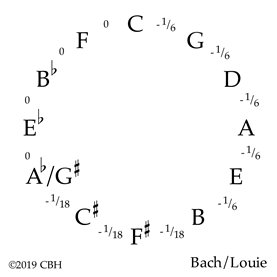Technical Library
TEMPERAMENTS XXVIII: Bach/Louie
Entire Contents Copyright © 2019 CBHTechnical LibraryTEMPERAMENTS XXVIII: Bach/Louie Entire Contents Copyright © 2019 CBH |
 Variation on a theme: An alternate interpretation of the squiggle was proposed by Canadian pianist and harpsichordist David Louie in his short essay from early 2018 titled “Decoding Bach’s Temperament—A Logical Interpretation and Practical Application of Bach’s Tuning Instruction on the Title Page of the Well-Tempered Clavier”.
Variation on a theme: An alternate interpretation of the squiggle was proposed by Canadian pianist and harpsichordist David Louie in his short essay from early 2018 titled “Decoding Bach’s Temperament—A Logical Interpretation and Practical Application of Bach’s Tuning Instruction on the Title Page of the Well-Tempered Clavier”. 
In common with Swich, Mr Louie takes F as his starting point on the squiggle, and runs in the direction of the flats. The similarity, though, ends there, because Mr Louie interprets the three squiggles differently. Working from left to right, he proposes the double loops be tuned pure, the single (empty) loops “slightly-tempered”, and the triple loops what he calls “normally-tempered”, or 1/6 comma because of the prevalence of that sized fifth in temperaments “in Germany at the time”. It’s an appealing conceit to have the triple loops tempered three times as much (1/6 comma narrow) as the single loops (1/18 comma) in this temperament. The author notes most other interpretations regard the empty loops in the squiggle as a direction to tune pure intervals, whereas here they are “slightly-tempered”.
When we plumb this temperament into our circle of fifths, we can see that the interpretation by Mr Louie of Bach’s squiggle is not so dissimilar to Bach/Hill with the normally-tempered fifths of that temperament transposed one notch sharp-wards. This is despite—or even perhaps a result of—Dr Hill having both a different starting point (E) and direction of travel (sharp-wards) on the squiggle, as well as his interpreting the loops to represent different sized intervals.
For instructions in how Mr Louie tunes his temperament from scratch, please refer to the essay on his website. But if you’re familiar with Young, you can very simply morph that into the Bach/Louie temperament by changing only two pitches (F♯ and C♯), effectively splitting the 1/6 comma fifth between B and F♯ into three equal parts of 1/18 comma, each smaller than an Equal-tempered fifth and in fact barely narrow at all:
1. Raise your f♯ to make a pure fifth above B, then lower your f♯ ever so slightly.
2. Raise your c♯' above f♯ to make a pure fifth, then likewise barely lower your c♯'. If you’ve done it corrrectly, your resultant c♯'–g♯' ever-so-slightly narrow fifth will be beating at about a third of the speed of c'–g' a semitone lower.
Musically speaking, if we compare the result of this temperament with Young, those three almost negligibly-narrowed fifths you have tuned have a cumulative effect, slightly improving the two distant tonalities of F♯ and C♯, albeit at the expense of the common keys of D and A.
If you’re working from a common Vallotti base instead of Young, you will have a few more steps because you must retune your four fifths on the flat side of C pure before proceeding as above.
| Pitch nomenclature | |
| Harpsichord Tuning Process | |
| Tuning Bibliography | |
| Technical Library overview | |
| Harpsichords Australia Home Page |